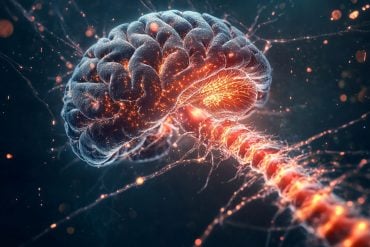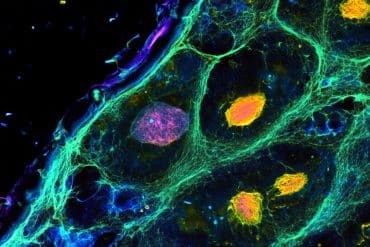Summary: Numerous recent studies have shown a link between exercise and improved cognitive performance in older people. A new study reveals dancing may have the most profound effect on cognitive health.
Source: Frontiers.
A comparison of 2 different fitness routines shows that both can have an anti-aging effect on the brain in the elderly, but only dancing gives rise to a measurable difference in behavior.
As we grow older we suffer a decline in mental and physical fitness, which can be made worse by conditions like Alzheimer’s disease. A new study, published in the open-access journal Frontiers in Human Neuroscience, shows that older people who routinely partake in physical exercise can reverse the signs of aging in the brain, and dancing has the most profound effect.
“Exercise has the beneficial effect of slowing down or even counteracting age-related decline in mental and physical capacity,” says Dr Kathrin Rehfeld, lead author of the study, based at the German center for Neurodegenerative Diseases, Magdeburg, Germany. “In this study, we show that two different types of physical exercise (dancing and endurance training) both increase the area of the brain that declines with age. In comparison, it was only dancing that lead to noticeable behavioral changes in terms of improved balance.”
Elderly volunteers, with an average age of 68, were recruited to the study and assigned either an eighteen-month weekly course of learning dance routines, or endurance and flexibility training. Both groups showed an increase in the hippocampus region of the brain. This is important because this area can be prone to age-related decline and is affected by diseases like Alzheimer’s. It also plays a key role in memory and learning, as well as keeping one’s balance.
While previous research has shown that physical exercise can combat age-related brain decline, it is not known if one type of exercise can be better than another. To assess this, the exercise routines given to the volunteers differed. The traditional fitness training program conducted mainly repetitive exercises, such as cycling or Nordic walking, but the dance group were challenged with something new each week.
Dr Rehfeld explains, “We tried to provide our seniors in the dance group with constantly changing dance routines of different genres (Jazz, Square, Latin-American and Line Dance). Steps, arm-patterns, formations, speed and rhythms were changed every second week to keep them in a constant learning process. The most challenging aspect for them was to recall the routines under the pressure of time and without any cues from the instructor.”

These extra challenges are thought to account for the noticeable difference in balance displayed by those participants in dancing group. Dr Rehfeld and her colleagues are building on this research to trial new fitness programs that have the potential of maximizing anti-aging effects on the brain.
“Right now, we are evaluating a new system called “Jymmin” (jamming and gymnastic). This is a sensor-based system which generates sounds (melodies, rhythm) based on physical activity. We know that dementia patients react strongly when listening to music. We want to combine the promising aspects of physical activity and active music making in a feasibility study with dementia patients.”
Dr Rehfeld concludes with advice that could get us up out of our seats and dancing to our favorite beat.
“I believe that everybody would like to live an independent and healthy life, for as long as possible. Physical activity is one of the lifestyle factors that can contribute to this, counteracting several risk factors and slowing down age-related decline. I think dancing is a powerful tool to set new challenges for body and mind, especially in older age.”
This study falls into a broader collection of research investigating the cognitive and neural effects of physical and cognitive activity across the lifespan.
Source: Melissa Cochrane – Frontiers
Image Source: NeuroscienceNews.com image is in the public domain.
Original Research: Full open access research for “Dancing or Fitness Sport? The Effects of Two Training Programs on Hippocampal Plasticity and Balance Abilities in Healthy Seniors” by Kathrin Rehfeld, Patrick Müller, Norman Aye, Marlen Schmicker, Milos Dordevic, Jörn Kaufmann, Anita Hökelmann and Notger G. Müller1, in Frontiers in Human Neuroscience. Published online June 15 2017 doi:10.3389/fnhum.2017.00305
[cbtabs][cbtab title=”MLA”]Frontiers “Dancing Can Reverse the Signs of Aging in the Brain.” NeuroscienceNews. NeuroscienceNews, 25 August 2017.
<https://neurosciencenews.com/dancing-brain-aging-7377/>.[/cbtab][cbtab title=”APA”]Frontiers (2017, August 25). Dancing Can Reverse the Signs of Aging in the Brain. NeuroscienceNew. Retrieved August 25, 2017 from https://neurosciencenews.com/dancing-brain-aging-7377/[/cbtab][cbtab title=”Chicago”]Frontiers “Dancing Can Reverse the Signs of Aging in the Brain.” https://neurosciencenews.com/dancing-brain-aging-7377/ (accessed August 25, 2017).[/cbtab][/cbtabs]
Abstract
Dancing or Fitness Sport? The Effects of Two Training Programs on Hippocampal Plasticity and Balance Abilities in Healthy Seniors
Age-related degenerations in brain structure are associated with balance disturbances and cognitive impairment. However, neuroplasticity is known to be preserved throughout lifespan and physical training studies with seniors could reveal volume increases in the hippocampus (HC), a region crucial for memory consolidation, learning and navigation in space, which were related to improvements in aerobic fitness. Moreover, a positive correlation between left HC volume and balance performance was observed. Dancing seems a promising intervention for both improving balance and brain structure in the elderly. It combines aerobic fitness, sensorimotor skills and cognitive demands while at the same time the risk of injuries is low. Hence, the present investigation compared the effects of an 18-month dancing intervention and traditional health fitness training on volumes of hippocampal subfields and balance abilities. Before and after intervention, balance was evaluated using the Sensory Organization Test and HC volumes were derived from magnetic resonance images (3T, MP-RAGE). Fourteen members of the dance (67.21 ± 3.78 years, seven females), and 12 members of the fitness group (68.67 ± 2.57 years, five females) completed the whole study. Both groups revealed hippocampal volume increases mainly in the left HC (CA1, CA2, subiculum). The dancers showed additional increases in the left dentate gyrus and the right subiculum. Moreover, only the dancers achieved a significant increase in the balance composite score. Hence, dancing constitutes a promising candidate in counteracting the age-related decline in physical and mental abilities.
“Dancing or Fitness Sport? The Effects of Two Training Programs on Hippocampal Plasticity and Balance Abilities in Healthy Seniors” by Kathrin Rehfeld, Patrick Müller, Norman Aye, Marlen Schmicker, Milos Dordevic, Jörn Kaufmann, Anita Hökelmann and Notger G. Müller1, in Frontiers in Human Neuroscience. Published online June 15 2017 doi:10.3389/fnhum.2017.00305






